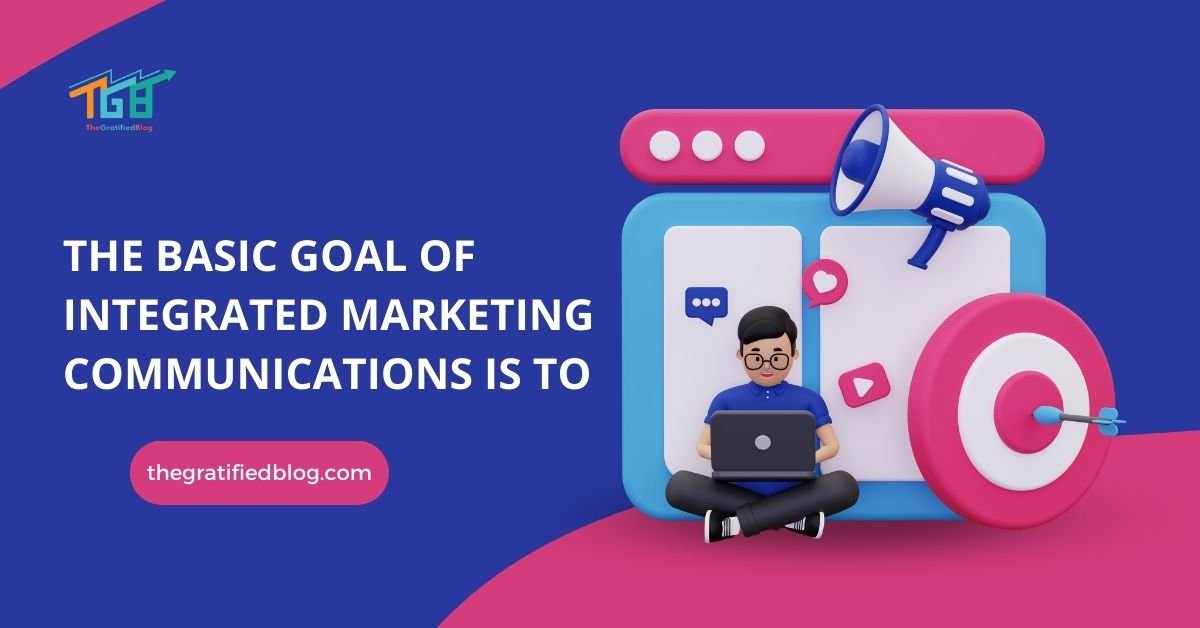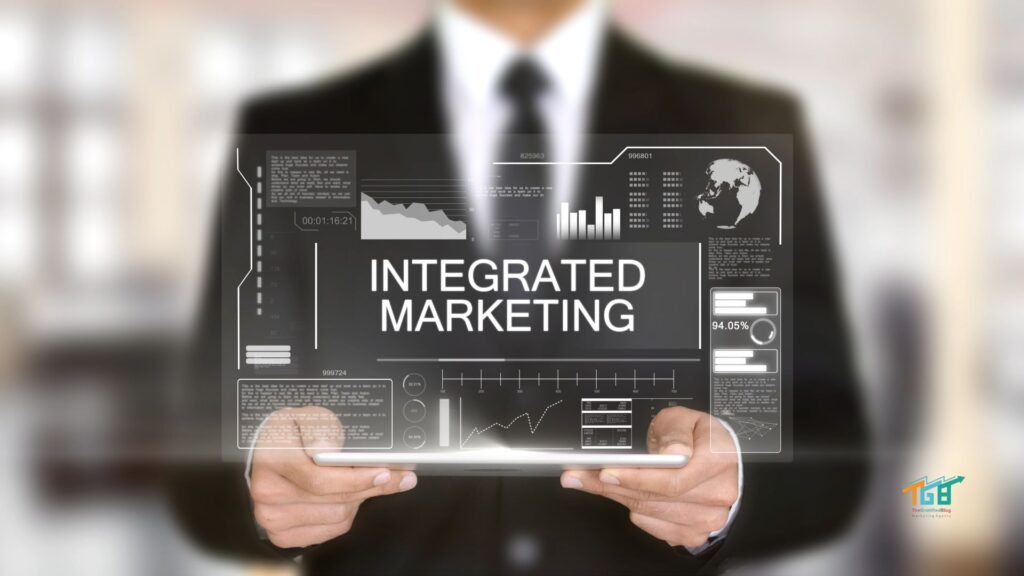
In today’s dynamic and interconnected business landscape, successful marketing strategies are crucial for organizations aiming to stand out amidst fierce competition. Integrated Marketing Communications (IMC) has emerged as a cornerstone of modern marketing, enabling companies to deliver cohesive and consistent messaging across various channels. However, understanding the fundamental goal of IMC is essential for maximizing its effectiveness. This comprehensive guide, “The basic goal of integrated marketing communications is to” delves into the core principles of IMC, its significance, and how it helps businesses achieve their objectives.
Unpacking Integrated Marketing Communications

To comprehend the fundamental goal of IMC, it’s imperative to grasp its essence first. Integrated Marketing Communications strategically coordinates various promotional elements and communication channels to deliver a unified message to target audiences. Unlike traditional marketing approaches, IMC integrates multiple marketing tools such as advertising, public relations, direct marketing, sales promotion, and digital marketing to create a seamless brand experience.
Integrated Marketing Communications (IMC) ensures consistency in marketing efforts across various channels and touchpoints. Here’s a breakdown of its key components:
Consistency
IMC emphasizes maintaining a consistent message and image across all communication channels, including advertising, public relations, direct marketing, social media, sales promotions, and personal selling.
Coordination
IMC coordinates all promotional mix elements to work harmoniously to achieve marketing objectives. This coordination ensures that each element reinforces the others, creating a unified and impactful message.
Customer-Centric Approach
IMC strongly emphasizes understanding and meeting the target audience’s needs. By integrating communication efforts, organizations can deliver a cohesive and relevant message to their customers, enhancing engagement and building stronger relationships.
Strategic Planning
IMC requires careful planning to align marketing activities with overall business goals. This involves identifying target audiences, selecting appropriate communication channels, and determining the most effective messaging and timing for reaching them.
Evaluation And Feedback
IMC continuously monitors and evaluates marketing activities to assess their effectiveness. By collecting feedback and analyzing results, organizations can identify areas for improvement and adjust their communication strategies accordingly.
Evolution Of Integrated Marketing Communications

Rapid technological advancements and shifting consumer behaviors have driven the evolution of marketing communications. Historically, marketing efforts were fragmented, with each department handling its promotions independently. However, with the emergence of digital media and the proliferation of communication channels, a need for a more integrated approach arose. IMC emerged as a response, aiming to align all marketing efforts towards a common goal: fostering brand consistency and synergy.
Here’s a broad overview of its evolution:
- Traditional Advertising Era (Pre-1960s): Before the 1960s, advertising channels were limited primarily to print, radio, and television. Marketers focused on creating separate advertising campaigns for each medium without much coordination.
- Introduction Of IMC Concept (1980s): Integrated Marketing Communications emerged in the 1980s as marketers recognized the need to coordinate various promotional elements to deliver a consistent message to consumers. This shift was partially in response to media fragmentation and the rise of niche audiences.
- Digital Revolution (1990s-2000s): The advent of the Internet and digital technologies revolutionized marketing communications. Marketers began incorporating websites, email marketing, and online advertising into their strategies alongside traditional media channels. This era saw the birth of customer relationship management (CRM) systems, which allowed companies to gather and analyze customer data for more targeted communications.
- Social Media And Content Marketing (2000s-Present): The rise of social media platforms like Facebook, Twitter, and Instagram provided marketers with new channels to engage with consumers directly. Content marketing became increasingly important, with brands creating valuable and relevant content to attract and retain customers. IMC strategies evolved to integrate social media and content marketing alongside traditional advertising channels.
- Mobile Marketing And Personalization (2010s-Present): The proliferation of smartphones and mobile devices led to a surge in mobile marketing efforts. Marketers began to leverage location-based targeting, push notifications, and mobile apps to reach consumers in real time. Personalization became a key focus, with brands using data analytics to deliver highly targeted and relevant messages to individual consumers.
- Omni-Channel Marketing (2010s-Present): Today, the focus of IMC has shifted towards omni-channel marketing, where brands strive to provide a seamless and integrated experience across multiple channels and touchpoints. This includes traditional media, digital channels, and offline channels such as events, retail stores, and customer service interactions.
- AI And Automation (Present-Future): Integrating artificial intelligence (AI) and marketing automation technologies is poised to transform IMC. AI-powered tools can analyze vast amounts of data to optimize marketing campaigns, personalize content at scale, and automate customer interactions across various channels.
The Basic Goal Of Integrated Marketing Communications Is To

At its core, IMC’s fundamental goal is to ensure that all marketing communications work harmoniously to convey a consistent brand message. This consistency is crucial for building brand equity, establishing brand identity, and enhancing brand recall among consumers. By coordinating various communication channels, IMC seeks to create a unified brand experience that resonates with the target audience across multiple touchpoints.
By integrating these communication channels, IMC strives to achieve several objectives:
Clarity
Communicating the brand’s value proposition, benefits, and unique selling points clearly and effectively to the target audience.
Reach
Maximizing the impact of marketing efforts by leveraging multiple channels to reach a wider audience and engage potential customers wherever they are.
Customer Engagement
Encouraging interaction and engagement with the brand by creating compelling content and experiences that resonate with the target audience.
Brand Loyalty
It builds strong, long-term customer relationships by delivering consistent, relevant communication that fosters trust and loyalty.
Cost-Effectiveness
Optimizing marketing spend by coordinating efforts and resources across different channels, maximizing the return on investment (ROI).
Ultimately, IMC’s goal is to create a holistic marketing strategy that enhances brand visibility, builds customer relationships, and drives business growth by delivering the right message to the right audience at the right time through the proper channels.
Achieving Synergy Across Communication Channels
One critical principle of IMC is achieving synergy across communication channels. Synergy refers to the combined effect of different marketing elements working together to produce a result more significant than the sum of their individual efforts. By coordinating advertising, public relations, social media, and other promotional activities, companies can amplify their brand message and create a more impactful impression on consumers.
Here are some strategies to achieve this synergy:
Consistent Brand Identity
Establish a clear and consistent brand identity across all communication channels. This includes maintaining consistent visual elements such as logos, color schemes, typography, and consistent messaging tone and style.
Integrated Messaging
Ensure that your messaging is aligned across all communication channels. Whether advertising, social media, email marketing, or in-store promotions, the key messages and brand story should remain consistent to avoid confusion and reinforce brand recall.
Cross-Channel Promotion
Use each communication channel to reinforce and amplify the message of other channels. For example, promote your social media campaigns through email newsletters, feature user-generated content from social media in your advertisements, or include QR codes in print ads that lead consumers to your website or social media pages.
Data Integration
Utilize data analytics to gather insights from each communication channel and integrate this data to create a more holistic view of your audience. This lets you personalize messages and tailor communication strategies across channels based on customer preferences and behaviors.
Seamless Customer Experience
Focus on creating a seamless and consistent customer experience across all touchpoints, whether online, offline, mobile, or in-person interactions. This includes ensuring a smooth transition between channels and that customers receive consistent information and support regardless of the channel they engage with.
Channel Optimization
Optimize each communication channel based on its strengths and audience preferences. Tailor content and messaging to suit the specific characteristics of each channel while maintaining overall brand consistency. For example, use visually appealing imagery on social media, concise and engaging copy in email marketing, and detailed product information on your website.
Feedback And Iteration
Collect feedback from customers across all communication channels and use this feedback to refine and improve your strategies. Monitor performance metrics such as engagement, conversion rates, and customer satisfaction to identify areas for optimization and iteration.
Enhancing Customer Engagement And Loyalty

Another critical goal of IMC is to enhance customer engagement and foster long-term loyalty. Companies can establish stronger connections with their target audience by delivering consistent and relevant messaging across multiple touchpoints. IMC helps businesses build customer relationships through personalized communication and interactive marketing initiatives, driving repeat purchases and advocacy.
Here are some strategies to achieve this:
- Understanding Your Audience: Start by deeply understanding your target audience’s preferences, behaviors, and needs. Use data analytics and market research to segment your audience and tailor your messages and offers accordingly.
- Consistent Brand Messaging: Ensure your brand messaging is consistent across all channels and touchpoints. Whether through advertising, social media, email, or in-store experiences, customers should receive a unified message that reflects your brand’s values and identity.
- Personalization: Use data-driven insights to personalize your communications with customers. Address them by name, recommend products or services based on their purchases or browsing history, and tailor promotions to their interests and preferences. Personalized communications make customers feel valued and understood, increasing engagement and loyalty.
- Omni-Channel Experience: Integrate all your marketing channels and touchpoints to provide a seamless omni-channel experience. Whether a customer interacts with your brand online, in-store, or via mobile, they should have a consistent and cohesive experience. This might involve integrating your online and offline data systems to track customer interactions across channels and personalize their experience accordingly.
- Interactive Content: Create interactive content that encourages customer engagement and participation. This could include interactive quizzes, polls, surveys, contests, or user-generated content campaigns. Interactive content captures attention and enables customers to actively engage with your brand, leading to a deeper connection and increased loyalty.
- Reward And Incentive Programs: Implement reward and incentive programs to incentivize repeat purchases and foster customer loyalty. This could involve offering loyalty points, discounts, exclusive offers, or VIP perks to customers who engage with your brand regularly or make repeat purchases. Ensure your rewards program is easy to understand, transparent, and offers meaningful benefits to customers.
- Social Listening And Engagement: Monitor social media channels for mentions of your brand, products, or industry keywords, and actively engage with customers by responding to comments, addressing concerns, and participating in conversations. Social listening allows you to gather valuable feedback, build customer relationships, and demonstrate that you value their input and opinions.
- Post-Purchase Engagement: Don’t neglect customers after they make a purchase. Follow up with personalized thank-you messages, order confirmations, and post-purchase emails that provide helpful information or resources related to their purchase. Encourage customers to share their feedback and experiences, and use this feedback to improve your products, services, and customer experience continuously.
Integrated Marketing Communication Tools
Integrated Marketing Communication (IMC) involves coordinating various promotional elements and communication channels to deliver a consistent message to target audiences. Here are some standard IMC tools:
- Advertising: Paid promotion through various media, such as TV, radio, print, online, and outdoor.
- Public Relations (PR): It involves building and maintaining relationships with the public and media to generate positive coverage and manage reputation.
- Sales Promotion: Short-term incentives to encourage purchases, such as discounts, coupons, contests, etc.
- Direct Marketing: Communicating directly with customers through email, direct mail, telemarketing, etc.
- Personal Selling: One-on-one interaction between sales representatives and potential customers to persuade them to purchase.
- Sponsorship: Associating the brand with events, sports teams, or causes to increase visibility and enhance brand image.
- Digital Marketing: Digital Marketing involves using online channels such as websites, social media, content marketing, search engine optimization (SEO), etc., to reach and engage target audiences.
- Social Media Marketing: Leveraging social media platforms to connect and interact with customers, share content, and build brand awareness.
- Content Marketing: Content Marketing involves creating and distributing valuable, relevant content to attract and retain a clearly defined audience and drive profitable customer action.
- Events And Experiential Marketing: Hosting or participating in events to engage with customers in person, allowing them to experience the brand firsthand.
- Influencer Marketing: Partnering with influential individuals or organizations to reach target audiences and build credibility.
- Point Of Purchase (POP) Displays: Promotional materials and displays at the point of sale to attract attention and influence purchasing decisions.
- Packaging: Designing product packaging to communicate brand values, differentiate from competitors, and attract consumers.
- Word-Of-Mouth (WOM) Marketing: Encouraging satisfied customers to spread positive word-of-mouth about the brand to their networks.
- Mobile Marketing: Targeting customers through mobile devices, such as SMS marketing, mobile apps, location-based marketing, etc.
Using integrated marketing communication tools, businesses can create a unified and impactful communication strategy to engage customers and achieve their marketing objectives.
Measuring Integrated Marketing Communications
To gauge the success of IMC efforts, it’s essential to establish key performance indicators (KPIs) and metrics for measurement. These may include brand awareness, customer engagement, sales revenue, website traffic, and social media interactions. By analyzing these metrics, companies can evaluate the impact of their integrated marketing campaigns and make data-driven decisions to optimize future strategies.
Here’s a structured approach:
- Brand Awareness: Monitor changes in brand recognition and recall among the target audience before and after the IMC campaign. This can be measured through surveys, website traffic, social media mentions, and search engine queries.
- Reach And Engagement: Analyze the reach of your IMC efforts across different channels, such as social media impressions, email open rates, website visits, and video views. Assess engagement metrics like comments, shares, likes, and retweets.
- Sales And Conversions: Track changes in sales, leads, and conversions attributable to the IMC campaign. Use tools like Google Analytics, CRM systems, and promotional codes to attribute sales directly to specific marketing channels.
- Customer Feedback And Sentiment: Gather customer feedback through surveys, reviews, and social media interactions to understand their perception of the campaign. Sentiment analysis tools can help quantify positive and negative sentiments.
- Cost-Effectiveness: Evaluate the cost per acquisition (CPA), return on investment (ROI), and cost per impression (CPI) for each marketing channel to determine the efficiency of your IMC strategy.
- Cross-Channel Consistency: Assess the consistency of messaging and branding across different channels to ensure alignment with the overall marketing objectives. Inconsistencies can dilute the campaign’s impact.
- Market Share And Competitive Analysis: Monitor changes in market share and track competitors’ performance to understand the relative effectiveness of your IMC efforts within the industry.
- Long-Term Impact: Measure the long-term effects of the IMC campaign on brand loyalty, customer lifetime value (CLV), and brand equity. These metrics may take time to manifest but are crucial indicators of sustained success.
- Attribution Modeling: Use attribution modeling techniques to attribute conversions to various touchpoints along the customer journey, allowing you to optimize your marketing mix for maximum impact.
- Experimentation And A/B Testing: Conduct experiments and A/B tests to compare different messaging, creative elements, and channels to identify the most effective combinations for your target audience.
Challenges And Best Practices In Integrated Marketing Communications
While IMC offers numerous advantages and disadvantages, its implementation can also pose challenges for organizations. These may include internal silos, budget constraints, and the complexity of managing multiple channels. However, by adopting best practices such as effective collaboration, leveraging technology, and continuous evaluation, companies can overcome these obstacles and maximize the impact of their integrated marketing efforts.
Frequently Asked Questions
Q1. What is Integrated Marketing Communications (IMC)?
Integrated Marketing Communications (IMC) is an approach to brand communication where different marketing channels and tools are strategically combined to deliver a unified and consistent message to target audiences. It aims to ensure that all aspects of marketing communications work together to create a seamless consumer experience.
Q2. Why is IMC important?
Ans. IMC is important because it helps companies present a cohesive and consistent message to their audience across various channels, which enhances brand recognition, credibility, and customer loyalty. By integrating different communication methods, companies can also improve the effectiveness of their marketing efforts and achieve better results.
Q3. What are the key components of IMC?
Ans. The key components of IMC include advertising, public relations, sales promotion, direct marketing, digital marketing, social media, and personal selling. These components are integrated and coordinated to complement each other and deliver a unified message to the target audience.
Q4. What are the benefits of using IMC?
Ans. Some benefits of using IMC include increased brand consistency and recognition, improved communication effectiveness, enhanced customer engagement, better ROI on marketing investments, and the ability to adapt to changing market conditions more effectively.
Q5. How can companies implement IMC effectively?
Ans. Effective implementation of IMC requires careful planning, coordination, and integration of all marketing communication activities. Companies should start by defining their target audience, setting clear objectives, and developing a cohesive brand message. They should also select the most appropriate communication channels and create a consistent brand image across all touchpoints.
Q6. What are marketing communication tools integrated?
Ans. Communication tools integrated marketing refers to the strategic blending of various communication channels such as advertising, public relations, direct marketing, social media, and sales promotions. This approach ensures consistency and synergy in conveying brand messages to target audiences, maximizing impact and effectiveness across multiple platforms.
Conclusion
In conclusion, the primary goal of Integrated Marketing Communications is to ensure consistency and synergy across all marketing channels to deliver a unified brand message. IMC enables organizations to build stronger brands, foster customer loyalty, and drive business growth in today’s competitive marketplace by aligning promotional efforts, enhancing customer engagement, and measuring effectiveness. Embracing the principles of IMC is essential for companies looking to thrive in an increasingly interconnected world of marketing communications.








No Comments